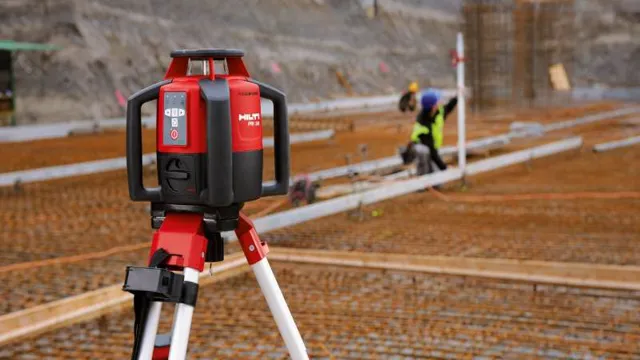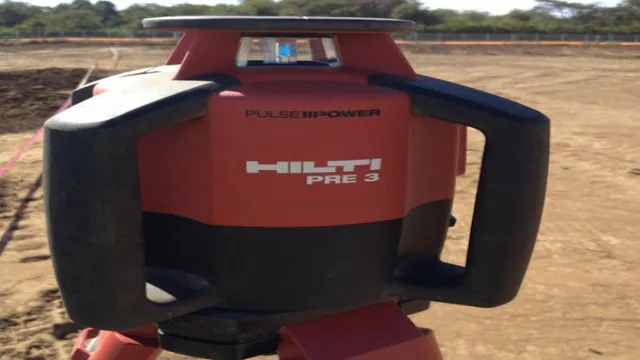How to Use Laser Level Machine: A Complete Guide for Accurate Measurements

If you’re tired of manually leveling everything in sight, it’s time to consider using a laser level machine. This powerful tool has revolutionized the way we work on home improvement projects, from hanging shelves to installing tile floors. But what exactly is a laser level machine, and how can you use it to simplify your work? In this article, we’ll delve into the benefits of using a laser level machine, explore different types of laser levels, and provide tips for working with this versatile tool.
Whether you’re a professional contractor or a DIY enthusiast, a laser level machine can help you achieve a precise and efficient result, so keep reading to learn more!
Understanding the Basics
If you’re a newbie to construction or DIY, understanding how to use a laser level machine may be a bit daunting. However, with proper guidance, this tool will make your work much easier and precise. First, ensure that the device is on a stable surface and leveled using the bubble vials.
Next, turn on the laser and adjust the projection height to your preferred level. Once the laser level has been set, you can start marking out your work area using the laser beam as your guide. You can also use it to check the alignment, focus, and levelness of different surfaces like floors, ceilings, and walls.
Using the laser level machine saves you time and guarantees accuracy in the completion of your project. With a little practice, you can become an expert in no time.
What is a Laser Level Machine?
A laser level machine is a tool used in construction or home improvement projects to ensure that surfaces are level and straight. It uses a laser beam to project a straight line onto a surface, providing a visual guide for workers to follow. These machines vary in size, power, and accuracy, depending on the specific needs of the project.
They can be used for a range of tasks, from laying tiles or flooring to aligning cabinets or shelves. Laser level machines are precise and efficient, making them a popular choice for professionals and DIY enthusiasts alike. With the help of a laser level machine, you can save time and ensure that your project is completed to a high standard.

Different Types of Laser Level Machines
Laser level machines have become an essential tool for construction, especially when it comes to creating a level surface or aligning items vertically or horizontally. These devices project a laser beam that can determine the level of an area over a range of distances. There are different types of laser level machines, including line laser, rotary laser, and dot laser.
A line laser produces a straight line across a surface and is commonly used for small to medium-sized construction projects. A rotary laser, on the other hand, projects a 360-degree beam and can cover larger areas. This type of machine is ideal for outdoor projects, such as laying the foundation of a building or landscaping.
Dot laser projects a single dot onto a surface and is best suited for indoor projects like hanging tiles, wallpaper, or shelves. Understanding the type of laser level machine required for a specific task will ensure that the project is completed with the highest accuracy and efficiency.
Importance of Accuracy and Calibration
The importance of accuracy and calibration in any measuring instrument cannot be overstated. When we use a measuring instrument, we expect the results to be as precise and reliable as possible. Hence, calibrating the instrument to ensure that it meets the required standards is vital.
Calibration involves comparing a measurement taken by the instrument under test to a reference measurement, which is traceable to an internationally recognized standard. The difference between the two measurements dictates the degree of accuracy or error in the instrument under test. Calibration is essential because it ensures that the instrument’s readings are reliable, consistent, and accurate.
This means that we can trust the instrument to provide us with the correct results consistently. Without calibration, the intrinsic errors in the measuring instrument could accumulate over time, leading to significant inaccuracies and inconsistencies in measurements. So, always ensure that your measuring instrument is calibrated regularly to avoid costly errors and unreliable results.
Preparing for Use
If you’re new to using a laser level machine, it can be overwhelming to figure out where to start. But don’t worry, it’s easier than it looks! The first thing you’ll want to do is ensure that the machine is fully charged, as you don’t want to run out of battery mid-project. Next, make sure that the laser is in good working condition and free from any debris that may obstruct the beam.
Once you’ve done so, choose the appropriate mode for your project – whether it be horizontal, vertical, or cross-line. It’s important to position the machine on a stable surface and adjust the height and angle as needed for the best results. Finally, turn the laser on, and you’re ready to go! With a little practice, using a laser level machine will become second nature, and you’ll achieve professional-level results in no time.
Choosing the Right Surface
Preparing your surface is essential before you start using it for any purpose. Whether it’s for painting, cooking, or writing, choosing the right surface is crucial to get the best results. First, ensure that the surface is free from any debris, dust, or dirt.
Use a damp cloth to clean it thoroughly and let it dry completely before proceeding. If you’re using a surface for writing or drawing, make sure there are no bumps or texture that may interfere with the smoothness of your work. Pick a surface that has a flat and even base to achieve the best results.
Choosing the right surface is important because it can impact the texture, clarity, and accuracy of your work. By taking the time and effort to prepare your surface, you’re ensuring that your final product will turn out great.
Setting Up the Machine
Setting up your machine to use efficiently is essential for a smooth workflow. It is crucial to follow the manufacturer’s guidelines to ensure that you do not miss any crucial steps while setting up. Before starting the machine, make sure it is placed on a flat surface, and check all of the cords are connected correctly.
Power on the machine and go through the settings to ensure that everything is correctly configured. It is also important to keep the device in good condition by cleaning it regularly and doing maintenance checks. By doing so, you will help extend its lifespan and ensure it runs at an optimal level.
Remember to follow the guidelines and maintain your device, and you can expect it to work efficiently for many years to come. Don’t forget to keep a record of maintenance to help keep track of when it needs cleaning or other maintenance and make it easier in the future.
Calibrating the Device
When it comes to using your device, it’s important to properly calibrate it before use. Calibration ensures that your device is accurately measuring and displaying information. The first step in calibrating your device is to ensure that it is clean and free of any debris that could interfere with the readings.
Once your device is clean, you will need to follow the manufacturer’s instructions for calibration, which may involve adjusting settings or using a calibration tool. It’s important to calibrate your device regularly, as factors such as temperature, humidity, and usage can affect its accuracy over time. By taking the time to properly calibrate your device, you can trust that you are getting accurate information and making informed decisions based on that information.
Using the Laser Level Machine
Using a laser level machine may seem like a daunting task, but with a few simple steps, you can use it like a pro. Firstly, choose the right location for the machine, ensuring that it is on a stable surface and is at the right height. Once the machine is in place, turn it on and let it calibrate.
This will ensure that it is accurate and ready to use. Next, set the level at the desired height and angle. This can be achieved by adjusting the screws on the base of the machine.
Finally, turn on the laser and use it to mark your reference points on the wall or surface. With a little bit of patience and practice, you will become a master at using the laser level machine. So, don’t be intimidated, give it a try!
Turning On and Off the Machine
When using a laser level machine, the first step is turning it on. This is essential to ensure that the machine is ready to use and give accurate results. Most laser level machines come with an on and off button or switch.
Ensure that the machine is placed on a flat surface before turning it on. Once turned on, the machine will project a laser beam that can be adjusted to the desired level. To turn off the machine, simply press the off button or switch.
It’s crucial to turn off the machine after use to preserve its battery life and prevent any accidents. By turning on and off your laser level machine correctly, you can ensure optimal performance, prolong the lifespan of the equipment, and ensure your safety as well. So, always remain vigilant while handling the laser level machine and follow the safety guidelines associated with it.
Adjusting the Height and Angle of the Laser Beam
Using a laser level machine requires adjusting the height and angle of the laser beam. Achieving the perfect level is essential for precise measurements and accurate results. To do this, first, decide on the height at which you want the laser beam to emit.
Set up the laser level machine at the appropriate distance, and then adjust the height of the tripod to achieve the desired level. The next step is to adjust the angle of the beam, which is done using the laser level machine’s controls. Turning the rotating head clockwise or anticlockwise changes the angle of the beam, and this should be done until the beam is level with the target.
Once the height and angle of the laser beam are adjusted, you can begin taking measurements with confidence. Laser level machines save time and effort, and with a little practice, you can achieve precise measurements in no time!
Marking the Reference Lines
When it comes to marking out reference lines, using a laser level machine is an excellent option. Not only does it save time, but it also ensures accurate measurements every time. The laser level machine projects a laser beam that indicates the line’s position, and all you need to do is follow it.
This is particularly useful when marking out borders, drilling holes or screwing objects onto a wall. The laser level machine removes the guesswork and ensures that everything is level, making the whole process quick and efficient. This means that you can easily hang pictures, install shelving or create artwork with ease.
With a laser level machine in hand, you can complete your projects with confidence, knowing that each reference line is accurate and precise. So why not invest in this handy tool and make your life easier?
Tips for Efficient Use
If you want to know how to use a laser level machine efficiently, here are some helpful tips. Firstly, make sure to read the instruction manual thoroughly and understand how the machine operates. Secondly, select the appropriate type of laser level for the job you are doing, whether it be a rotary laser level for indoor and outdoor use or line laser level for smaller indoor projects.
Thirdly, ensure the machine is set up correctly and securely placed on a stable surface to avoid any unwanted movement during use. Fourthly, use the laser detector when working in brightly lit environments or outdoors to ensure accurate measurements. Lastly, take regular breaks to prevent fatigue and ensure the accuracy of your work remains consistent.
By following these tips, you can use a laser level machine efficiently and effectively for any project you may have.
Maintaining the Machine
Maintaining your machine is crucial to prolonging its life and ensuring optimal performance. First and foremost, always read the user manual and follow the recommended maintenance procedures. Regularly clean and replace air and oil filters, as clogged filters can cause overheating and decrease efficiency.
Additionally, keeping the machine lubricated with the proper oil or grease can reduce friction and wear on moving parts. It’s also essential to regularly inspect belts, hoses, and other components for wear or damage and replace as needed. Finally, consider investing in quality replacement parts to ensure that your machine operates at peak performance and avoid costly breakdowns or repairs.
By following these tips, you can keep your machine running smoothly and efficiently for years to come.
Anticipating Common Errors
Anticipating common errors can save you a lot of time and frustration, whether you’re writing an essay, coding a program, or creating a presentation. To make the most of your work and avoid mistakes, here are a few tips for efficient use. First, take the time to outline your project or task and identify potential mistakes ahead of time.
This can help you catch errors before they happen and correct them before they become bigger problems. Second, make sure you understand the instructions and details of your task or assignment, so you can avoid mistakes caused by miscommunication or misinterpretation. Finally, don’t be afraid to ask for help or to seek feedback from others.
This can help you catch errors and make improvements to your work, ensuring a better final product. By anticipating common errors and following these tips, you can save time, reduce stress, and produce high-quality work that meets or exceeds your expectations.
Consulting the User Manual
When it comes to getting the most out of any product, it’s always a good idea to consult the user manual. Whether it’s a new gadget or a complex software system, taking the time to read through the instructions can save you a lot of time and frustration in the long run. But simply skimming through the manual isn’t enough – to really use the product efficiently, you need to pay attention to key details.
Start by familiarizing yourself with the basics, like how to power on the device or access key features. From there, dive into the more advanced settings, taking note of any customization options that could improve your experience. Don’t be afraid to experiment and tinker with different settings until you find what works best for you.
By using the user manual as a guide, you can make the most of your product and get the most value possible.
Conclusion
Using a laser level machine can seem daunting at first, but it’s actually quite simple. Just remember to take your time, read the instructions carefully, and make sure the surface you’re using is level. And if all else fails, just aim the laser at your least favorite co-worker’s desk and let them figure it out.
Just kidding, don’t do that. But seriously, with a little patience and practice, you’ll be leveling like a pro in no time.”
FAQs
What is a laser level machine and how does it work?
A laser level machine is a tool that projects a laser beam to help with accurate leveling and alignment in construction and DIY projects. The machine uses a self-leveling pendulum system to maintain accuracy and allows for projection onto vertical and horizontal surfaces.
What are the different types of laser level machines?
There are three main types of laser level machines: dot laser level, line laser level, and rotary laser level. Dot laser level projects single or multiple dots for plumb points. Line laser level projects lines for leveling and alignment. Rotary laser level projects a rotating beam for leveling over long distances.
How do you calibrate a laser level machine?
To calibrate a laser level machine, place it on a level surface and turn it on. Allow it to self-level, then adjust any discrepancies using the calibration screws or knobs until it reaches level. Repeat the process until accurate.
How can you use a laser level machine for hanging shelves or cabinets?
To hang shelves or cabinets, you can use a line laser level to project a level line to mark the wall where the screws or brackets need to be placed. This ensures that the shelves or cabinets are always level and straight.
Can a laser level machine be used outdoors?
Yes, some laser level machines are designed to be used outdoors. Rotary laser levels are the most suitable for outdoor use as they can project a beam over long distances and are visible in bright daylight.
How do you use a laser level machine for laying tiles?
To use a laser level machine for laying tiles, you can project a level line across the floor using a line laser level. This line will serve as a guide for laying the tiles evenly and straight.
Is it necessary to wear protective eyewear when using a laser level machine?
Yes, it is recommended to wear protective eyewear when using a laser level machine. The laser beam can cause damage to the eyes if directly viewed, so it’s important to take precautions.



